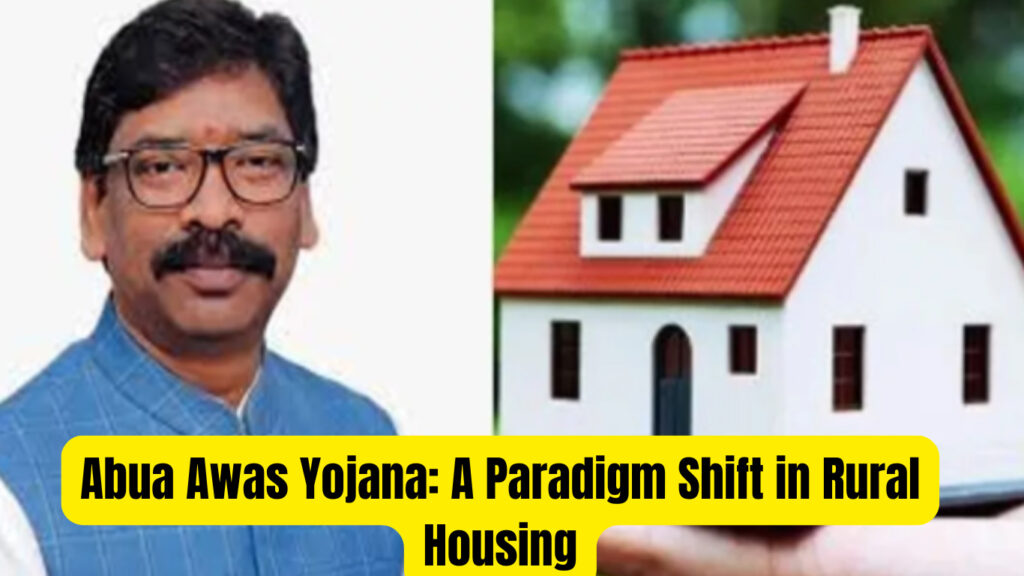
Abua Awas Yojana: A Paradigm Shift in Rural Housing
The Abua Awas Yojana is one of the flagship housing schemes of the Jharkhand government, as it aims at diminishing the worst form of deprivation amongst the rural poor-a lack of shelter. This scheme, underlining constructions that are durable and well-designed homes for deprived families, underlines the commitment of the state to social equity and inclusive development. The ambitious project has already gained so much attention for the ingenuity and potential to transform a lot of living conditions, where the aim is to build 8 lakh pucca houses by 2026, with 2 lakh in 2025.
Table of Contents
Vision and Objectives
This Abua Awas Yojana goes way beyond just offering shelter; it aims at laying down a foundation for wholesome rural development. Main objectives of it are to:-
1. Housing Shortages: The programme is intended to provide homes for kutcha and dilapidated house dwellers; such families would be able to enjoy safe, dignified, and comfortable living conditions.
2. Social Equity: Women beneficiaries and other marginalized groups are targeted by this programme that contributes towards equity and empowerment.
3. Complementing National Efforts: AAY intends to fill in the gaps of the housing schemes already existing, and the Pradhan Mantri Awas Yojana appears to be a great source, especially for vulnerable sections and those which were earlier left out.
How Uttar Pradesh’s Free Water Scheme Will Revolutionize Farming in 2024-25
Uttar Pradesh Transformation: Road to 1.1 Crore Jobs by 2025 with Rs 40 Lakh Crore Investments
Features of Abua Housing Scheme
1. Well-Planned Design for Housing
Houses of 31 square meters in each have three rooms, a kitchen, and one toilet. Such a design reflects improvement over similar schemes: comfort and functionality along with durability are highlighted.
2. Financial Incentives
The government has also been granting a subsidy of ₹2 lakh per house. This amount is given in four installments. This pattern helps the house under construction to reach a pace of work while at the same time maintaining its standards of quality.
3. Women-Friendly Policy
Houses are registered in the name of the female head of family, so registration encourages gender equality and financial security. The resultant challenge placed on women is to play a more responsible role in household decision-making.
4. Employment Integration
The approach for such a housing needs-based facility also supports the Mahatma Gandhi National Rural Employment Guarantee Scheme, which guarantees wages up to 95 days of unskilled labor, thereby guaranteeing much-needed financial support to rural workers. It serves two birds-rural unemployment and housing needs in their backyard.
5. Sanitation and Hygiene
It talks about building toilets in every house, which is supported by the Swachh Bharat Mission. It thereby improves sanitation and contributes to public health.
Eligibility Criteria and Exclusions
The scheme is minutely crafted so that it zeroes down to the truly deserving families. As such
Eligibility :
– Families having no pucca house. Not covered under any other housing schemes. PVTGs. Families affected by natural calamities and extreme poor families.
Exclusions:
– Families with significant agricultural assets or modern amenities like refrigerators.
– Government and semi-government employees.
– Income tax and professional tax payers. This strict eligibility criterion ensures that the scarce resources reach the targeted beneficiaries only when they are actually in need.
Implementation and Cost
The Abua Awas Yojana is a ₹16,320 crore program, under three stages:
– Phase 1 (2024): Would construct 2 lakh houses.
– Phase 2 (2025): To be expanded to 3.5 lakh houses.
– Phase 3 (2026): To be completed for remaining 2.5 lakh houses.
The state resources are funded supplemented by synergies from central government programmes such as MGNREGS and Swachh Bharat Mission.
Beneficiary selection is done in a transparent manner at the gram sabha level. Applications undergo strict verification by the local authorities to rule out mistakes and make it fair and just.
Economic and Social Impact
Abua Awas Yojana is a transformative initiative with farreaching implications for rural Jharkhand:
1. Improved Living Standards
This provides for housing needs but, importantly, enhances conditions of living through the construction of larger and better-designed houses with all facilities in place.
2. Rural Economy Boost
The scheme fosters local economies through the employment that is generated during construction work.From the demand generated through construction activity, the requirement of materials and labor creates a multiplier effect.
3. Social Empowerment
Ownership of houses is by women: it proves to be a measure of gender equity, and provisioning for other weaker sections serves as a social equity.
4. Public Health and Hygiene
Sanitary facilities improve the health of a community by reducing open defecation and unhealthy conditions.
Working application
Families wanting to benefit from the Abua Awas Yojana can obtain it through any of the following approaches:
1. Office of Local Panchayats
Applications are accepted at gram sabha or block offices where officials assist and guide one through the application process.
2. Online Portal
The state government has specially made a website for the scheme. It helps the applicant to easily get information about the scheme and to submit the application.
3. Government Outreach Programs
Initiatives such as “Apki Yojana, Apki Sarkar, Apke Dwar” also support on-ground registration and awareness campaigns.
Applicants are required to present proof of identity, residence, and income, which is cross-checked by the concerned authorities before getting listed under the beneficiary list.
Challenges and Mitigation Strategies
The very ambitious scope of Abua Awas Yojana comes with many challenges:
1.On-Time Execution
Proper coordination among different departments and contractors should be able to ensure timely completion of houses.
2. Identification of Beneficiaries
It is in this step that none should make or present any error or fraudulent claims. The government has verification processes that ensure it minimizes the capability for errors or fraudulent claims.
3. Resource Allocation
There is a necessity to control the budget while ensuring that all phases receive sufficient funds to make the scheme a success. Transparent financial planning and monitoring are sought after.
Success stories and testimonials
Several families that were once living in precarious conditions are now enjoying the security of a well-built home, and women who receive property appear to have higher confidence to speak in family and community matters. Early beneficiaries of the Abua Awas Yojana are already reaping the benefits of these changes.
For example, one tribal family from Ranchi spoke of their improved standard of living-they boasted of a stable environment for their children’s education and health after moving under AAY.
Conclusion
Abua Awas Yojana is not just a scheme of houses, but it is the hope of rural Jharkhand. In an age that addresses and redresses housing, employment, and social inequality all at once, this scheme will be a benchmark for inclusive development. While the state is working towards the result of constructing 8 lakh homes, the scheme promises to undergo complete changes in the lives of numerous families, ushering in dignity, security, and opportunity.
For the exact details of this policy or applying procedure, visit the Jharkhand Rural Development Department’s official portal or your nearest local panchayat office.
Effective balancing of ambition with practicality, Abua Awas Yojana will become a model for all other states of the country that will surely make “Housing for All” a true reality in India.




I am extremely impressed with your writing talents and also with the format for your blog. Is that this a paid topic or did you modify it your self? Either way keep up the nice quality writing, it’s rare to see a great blog like this one these days!